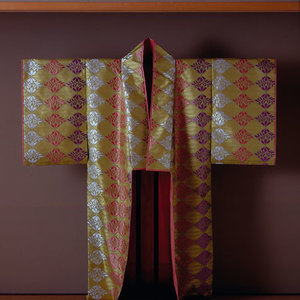
Nicholas Godley, left, and Simon Peers at the American Museum of Natural History with the hand-woven fabric
Last week the American Museum of Natural History unveiled a cloth woven entirely from the silk spun by female golden orb spiders of Madagascar.
This silk has a natural saffron color and has a strength five to six times stronger than steel.
The harvesting technique reads like a tragic epic with every possible problem nature could throw at the scientists: Only the females make the silk, but they’re prone to eating each other and will completely destroy one another if left alone too long. These arachnid ladies also only spin in the winter, but only when rain conditions are just right.
Five years ago fashion designer Nicholas Godley paired up with a British scientist, Simon Peers, to try and harvest the silk from the spiders. Last week their hard work went on display at the museum and will be there for six months. It took more than 80 people to create this breathtaking textile that was woven with traditional, royal designs from Madagascar.
Godley and Peers are not the first to try this amazing feat–Francois Xavier Bon de Saint Hilaire created an entire suit for Louis the XIV in 1710 from spider cocoon silk.
The process and history of this is truly fascinating and you can learn more about it in the feature on the New York Times website or read more on the American Museum of Natural History’s site. They also have a video documenting details of the cloth.


































This is very interesting!
Thank you so much for writing a great article. I have always been fascinated by spiders because of the beautiful webs that they weave. The effort that went into making the spider silk cloth may have been a challenge but well worth the effort.
thank you so much
It is amazing to see what wonderful things can be done when you set your mind to it. Great going, wish I could see this piece of wonder in person.
I am speechless (but not quite). Spiders produce a sticky silk which holds prey until the spider can immobilize it, as well as a non-sticky structural silk. They walk on the non-sticky lines to avoid being ensnared themselves. What I want to know is, how do you persuade the captive spider to produce only the non-sticky kind for weaving??
I remember my summer as a student Intern at The American Museum of Natural History and how incredibly fascinating it was to be there every day. I've been interested in the study of textiles for quite a long time, especially with my archaeological background, this weaving definetly sparks my interest in studying not only plant and man-made fibers, but how we can use other natural resources for fabric. So great that you are featuring this!
This is very fascinating. The American Museum of Natural History is such a great museum, I'll have to read more about this weaving and about Madagascar.
A few years ago you posted an article on this subject. There was an amasing cape on display at the Victoria and Albert Museun in London Ehgland and as I was in England at the time, I went to see it. It. was absolutey stunning and if it wasn't for yout article I would have missed out on an opportunity that only comes once in a lifetime. I will not be able to get to New York, but thank you to Threads for sharing this silk with the world.